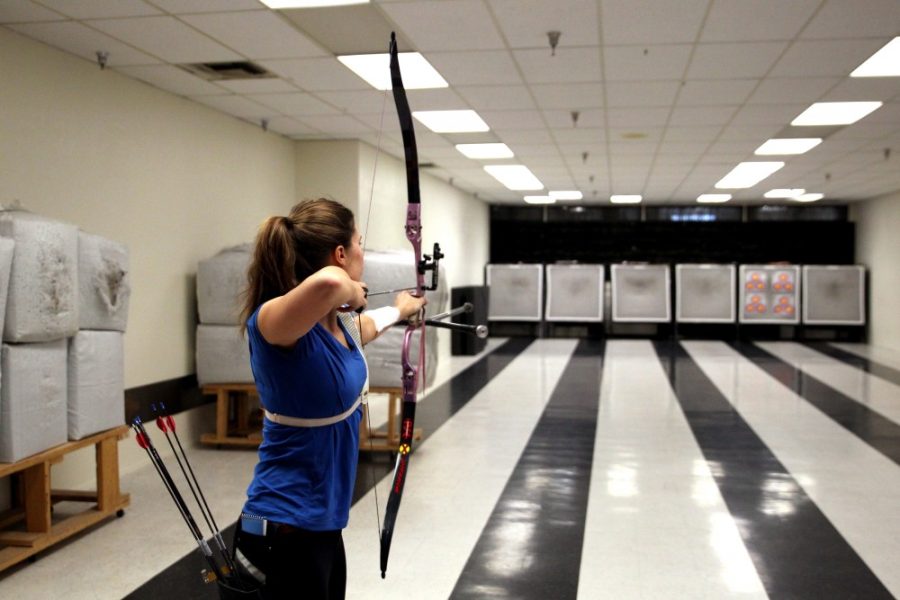Anyone who has ever taken a physics class will recognize Newton’s laws of motion and Albert Einstein’s famous equations. But for archers, the principles of physics, math and psychology extend far beyond the classroom. While many archers may not always think about the scientific and mathematical theories that come into play with archery, shooting a bow provides quintessential real life examples of these theories.
Connecting science and math
The Wildcat Archery club puts science and math to use with every practice. In order to hit the target, the archers must overcome a phenomenon called the Archer’s Paradox.
The paradox explains the fact that although the arrow is pointed slightly off-kilter from the target before release, it will still hit the target. Much of archery is experimenting to find the best way to make the arrow travel as straight as possible. The arrow, however, will never travel truly straight. Adjustments to the spine and stiffness of the arrow are two ways to address the Archer’s Paradox.
“[It] is what causes us to choose what spine or stiffness of an arrow is appropriate for an archer,” said Sandra Childress, a UA alumna and the volunteer coach of Wildcat Archery. “It’s like trying to shoot a soft spaghetti noodle versus an uncooked spaghetti noodle. That soft spaghetti noodle has a soft spine, so it will wiggle and the stiffer the spine, the less it will wiggle; the whole arrow will wiggle, instead of just the middle.”
For archers, the ultimate goal is to land in the sweet spot. In order to hit their sweet spot, archers must have an awareness of their own form and their surroundings.
“That sweet spot for me, there are two elements to it,” Childress said. “One, the arrow is landing where I want it to be: the x, the gold ring. To make that happen, it’s a combination of the anchor point on my face, the grip in my hand, the draw length and the position of my shoulders, and my entire form. When it’s all correct, you should be hitting the sweet spot, because you are in your sweet spot.”
Archers must also have a basic understanding of physics, as well as geometry, trigonometry and algebra. Taking into account arcs and vectors is a large part of determining where the arrow will hit. In order to get the perfect shot, you must get the arrow as fast and flat as possible.
“One-eighths of an inch change at the archer’s position can be upwards, depending on the distance, of anywhere from 2 inches to 6 inches,” Childress said.
All these factors can change based on the type of target you are shooting. In field archery especially, the variability of the trails causes changes in the archers’ angles.
“You could be up on a hill shooting downwards, so now your planar geometry is coming in the fact that now you have the force of gravity, because you are going to shoot down,” Childress said.
The grip on the bow is also important for maximizing the amount of potential energy that can be extended into the bow.
Childress has found that the biggest mistake that beginning archers make is gripping their bow too tightly, sometimes causing them to misdirect the arrow.
“As you grip tighter on the handle of the bow, you tighten your wrist, you tighten your elbow, or you lock your shoulder and that now becomes a stiff arm,” Childress said. “That stiff arm steals all the energy, and absorbs the velocity that you are going to have.”
Preparing for the Olympics
Wildcat Archery also has an Olympic hopeful, Madison Eich, a mechanical engineering sophomore. For her, psychology and STEM connections are helping in her preparations for the second stage of Olympic trials in April.
Eich is mentally preparing herself. She practices five times a week for two to four hours each practice. At each practice, she aims to shoot 150 arrows. Being able to show this kind of dedication to the sport takes time management skills as she works to balance school and archery.
“The soft science would be psychology,” Childress said. “How do you keep yourself focused for an hour’s worth of shooting when you’re shooting a regiment of three or six or 12 arrows and then you are retrieving, so you break that mental space. And, when that one bad arrow happens, how do you stay focused?”
Eich’s biggest weakness is competing and the psychological force associated with it. Although, when shooting, Eich considers the science and math of archery, especially when in drawback.
“When I come back into anchor, there is an angular movement that your body has to the bow’s weight,” Eich said. “Subconsciously, I don’t think about it, but when you start pulling back the bow, your brain kicks in and is like, ‘oh, I am actually pulling some weight: what muscles do I use, how in line do I have to be with the arrow so that I can shoot the arrow well enough.’”
Eich said she also finds many parallels between her engineering classes and archery. One of the most prevalent ones is her understanding of kinematics and statics. She said it has helped her better understand how her bow works and what forces are acting within her bow.
“Especially as an archer, you really get to understand how your bow works and understand the fundamentals of mathematics and physics, and how the mechanism works in relation to your body,” Eich said.
Grasping the connection between science and math, and being able to contextualize this understanding is an important part of an archer’s ability to hit the bull’s-eye.
Follow Natalie Robbins on Twitter.









